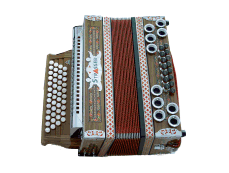|
Following pages
Thanks to Johann Pascher and Orest Lechnowsky for the translation.
|
The “Steirische”Written by Hermann HaertelSome call the instrument "button box " and derive the name from the number of buttons, which appears confusing to most people. Others say squeezebox. The name probably sounds somewhat crude, nevertheless it is something that is squeezed. There are a lot of other different names, which some gave to this strange instrument over the course of the years: Zugorgel, Zugin, Wanzenpress, Ziach, Ziachharmonie, harmonika or only "Steirische". What makes the “steirische harmonika” so strange and yet so well liked beside the diatonic principle? First of all it cannot simply be used by everyone, and then there is still this strange appearance: two square boxes containing hidden parts and these two boxes are kept together with these bellows in between. Then it has this shiny surface and metal decorations everywhere which attracts some people more than the sound. The bass sound comes from horns, the air button hangs completely loose from the box. The belt, richly decorated with flowers, is fastened with a large wood screw. The buttons, already mentioned, generate rattling noises when the instrument is in use, interrupted with a constant asthmatic breathing noise. That is the steirische harmonika - a love-worthy instrument, a part of the musician himself. An instrument, which forces the musician to carry some repairtools along with him all the time. What musician has not had to remove the nails or had to open the front or the back cover of this instrument to fiddle around inside to fix minor problems? Sometimes it rattles too much, leaves out some tones or sends tones of discord into the so well intended melody! What may such an old "Steirische" already have seen? Probably everything in every way. How many musicians already put their fingers onto these buttons? Didn’t it change our alpine country music and didn't it keep our country music alive? Such questions probably can only be understood, by some older folks who have already seen such a scathed and caved-in "Steirische" before. Such an object, with fragile bellows, with funny curved bass horns, with a voice rough and injured, with innumerable dance evenings on its back. Only after many years has it retired - A new one must be come into existence, and again a "Steirische" -, which lends the necessary accents to the dancing legs on the dance floor, with its strange tremolo sound. This is a translation of an article by Hermann Haertel and it was taken from the magazine "Der Froehliche Kreis", 26. Jahrgang/1976, number 2. |
![]()
[Deutsche Version]

